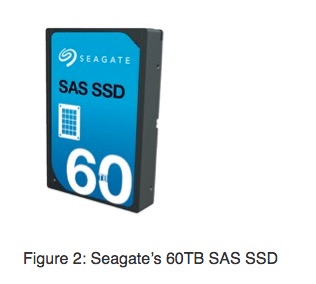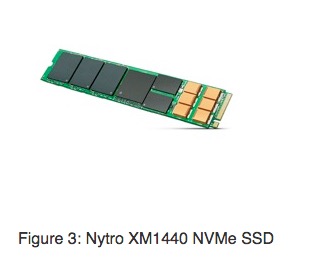As we look ahead at the dawn of 2017 to driving innovations that meet new customer goals, it’s important to reflect on our previous year’s ambitions and the successes that come from our enormous R&D efforts — we invest about a billion dollars a year in R&D across our hard drive, SSD, systems and software businesses to deliver technology advances for every customer. Among our firsts, as part of our Cloud Systems and Silicon Group (CSSG) team I’m proud we unveiled three SSD technologies in 2016 that stand as the fastest, largest and densest ever developed — we call this accomplishment “FLD.”
I’ll explain the details about FLD more in depth in the post below, but it’s exciting to note these SSD accomplishments are also part of a much wider set of advances Seagate achieved in 2016. Just a few of these successes:
- World’s fastest hard drive (for enterprise mission-critical applications)
- First 10TB hard drives for compute, network-attached storage and video surveillance
- Highest-capacity laptop and portable external drives
- Fastest external drives for consumers and creative professionals
- First USB-powered desktop external drive and the first with integrated front-facing USB ports to charge and backup multiple devices
- Highest-capacity desktop storage (96TB!) for creative professionals
- Best enterprise scale-out storage systems technology for High-Performance Computing, and
- Shipped the first sample drives to customers using Heat Assisted Magnetic Recording technology straight out of the lab.
Leading Breakthroughs in SSD — Fastest, Largest, Densest
Working on the CSSG team, I’m constantly impressed with our SSD research engineers’ work.
Seagate never stops raising the bar in the SSD world, and through 2016, the company managed to chalk up an impressive list of firsts and continued to solidify our position as a leader bringing advanced, cutting-edge SSD technologies to the enterprise space. Many tech developers are happy to produce the best of any one thing, but Seagate has worked to develop a full suite of products that have no peers.
The company refers to this accomplishment as “FLD,” for fastest, largest and densest, and with a slew of announcements in 2016 introducing the winning products to the world, we’ve extended our global technology leadership in three important categories. The feat has earned accolades, but the titles “FLD” pack more significance if you have a clear understanding of what they mean and why they’re significant.
Fastest
 When Seagate announced its 8TB Nytro XP7200 NVMe SSD add-in card (AIC) in August, it reached a new pinnacle in the effort to build the fastest enterprise SSD solution. The Nytro XP7200 uses a single PCIe Gen3 x16 interface with individual controllers to access four 2TB Nytro XP7200 NVMe M.2 drives (more on these later). Its throughput rate of 10GB/s easily surpasses the rate of the next-fastest SSD: Seagate’s own 4GB/s Nytro XP6500 flash accelerator card, which was released in August 2015.
When Seagate announced its 8TB Nytro XP7200 NVMe SSD add-in card (AIC) in August, it reached a new pinnacle in the effort to build the fastest enterprise SSD solution. The Nytro XP7200 uses a single PCIe Gen3 x16 interface with individual controllers to access four 2TB Nytro XP7200 NVMe M.2 drives (more on these later). Its throughput rate of 10GB/s easily surpasses the rate of the next-fastest SSD: Seagate’s own 4GB/s Nytro XP6500 flash accelerator card, which was released in August 2015.
Speed is generally measured in terms of throughput rate, which indicates the amount of data that can be transferred to and from a storage device during any given measure of time — the higher the rate, the better. No matter how powerful the processing power, systems running applications that require the most intense reading and writing of data can see their greatest performance gains when the storage device they use can keep pace with processor capabilities. In general, because a storage device can present one of the performance bottlenecks in modern computer systems, increasing the speed of the storage medium can result in an immediate and noticeable improvement in performance for the entire system.
There may be many reasons somebody (or something) might consider utilizing the fastest SSD available, but organizations that would most benefit from this kind of performance include those where speed matters most for results, such as large-scale cloud providers and web applications, weather modeling or statistical trends analysis.
Largest
 Seagate also sits atop the chart that lists the largest — meaning highest-capacity — SSDs ever introduced. The monster 60TB SAS SSD that was unveiled at the Flash Memory Summit (FMS) in August nearly doubles the 32TB capacity of the next-highest-capacity SSD introduced at the same show by another company. The Seagate product was such a hit at FMS that it won the Best of Show award for Most Innovative Flash Memory Technology at the convention.
Seagate also sits atop the chart that lists the largest — meaning highest-capacity — SSDs ever introduced. The monster 60TB SAS SSD that was unveiled at the Flash Memory Summit (FMS) in August nearly doubles the 32TB capacity of the next-highest-capacity SSD introduced at the same show by another company. The Seagate product was such a hit at FMS that it won the Best of Show award for Most Innovative Flash Memory Technology at the convention.
The size of a storage medium is probably the metric that people recognize and understand most. Quite simply, the higher the capacity, the more data can be stored on it. But what does that mean in everyday terms? On this single 3.5-inch SSD, which can fit in the palm of your hand, you can store hundreds of millions of photos or more than 13,000 DVD-quality movies!
Whereas the above-mentioned Nytro XP7200 NVMe SSD’s major strength is its speed, the 60TB SAS SSD is optimized for higher-capacity applications that nevertheless demand regular intense data access. As such, it was designed for high-read-intensity tiers in large storage arrays, active archiving scenarios (archives in which data is read frequently but written to infrequently) and other read-intensive environments.
Densest
 Rounding out the unprecedented advances is the 2TB Nytro XM1440 production-ready M.2 card, which Seagate announced in July. It has the distinction of being the densest enterprise-class M.2 SSD on the market. M.2 is a relatively new SSD standard that features smaller form factors than older standards and can connect to many different kinds of buses, including PCIe and SATA.
Rounding out the unprecedented advances is the 2TB Nytro XM1440 production-ready M.2 card, which Seagate announced in July. It has the distinction of being the densest enterprise-class M.2 SSD on the market. M.2 is a relatively new SSD standard that features smaller form factors than older standards and can connect to many different kinds of buses, including PCIe and SATA.
Density measures the amount of data that can fit into a given amount of volume. Typically the higher the density the better, as it means more capacity can be achieved in increasingly shrinking available physical real estate. To date, other solutions have managed to cram 2TB of storage capacity into a client-centered M.2 SSD, but Seagate is alone in doing so in an enterprise-class solution. Because Seagate was able to include capacitors to support power-failure protection in its Nytro XM1440, enterprises can rest assured that their data can be written successfully to the flash memory in the event of an unexpected power loss.
The Nytro XM1440’s unrivaled capacity and small form factor make the product ideal for cloud and enterprise data center environments, where speed and processing power in a small footprint are at a premium.







